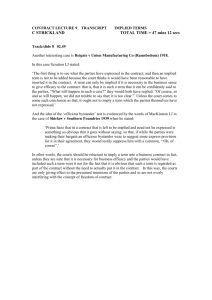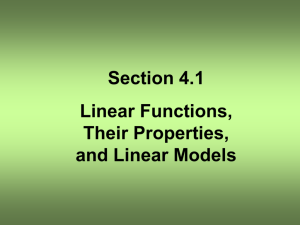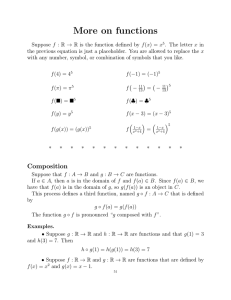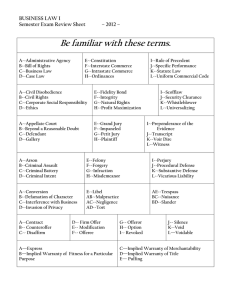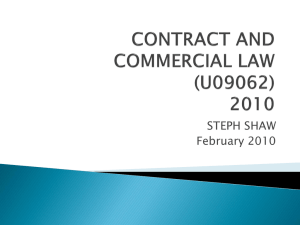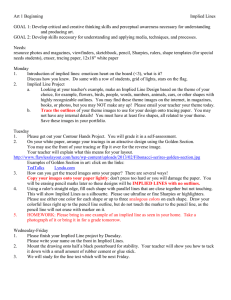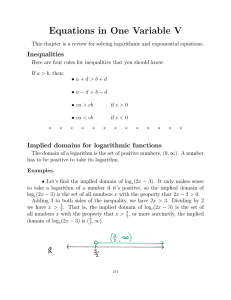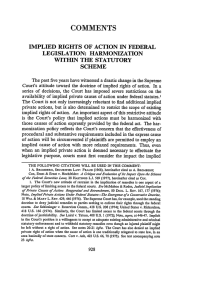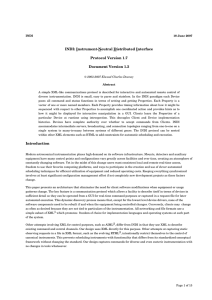More on functions
advertisement
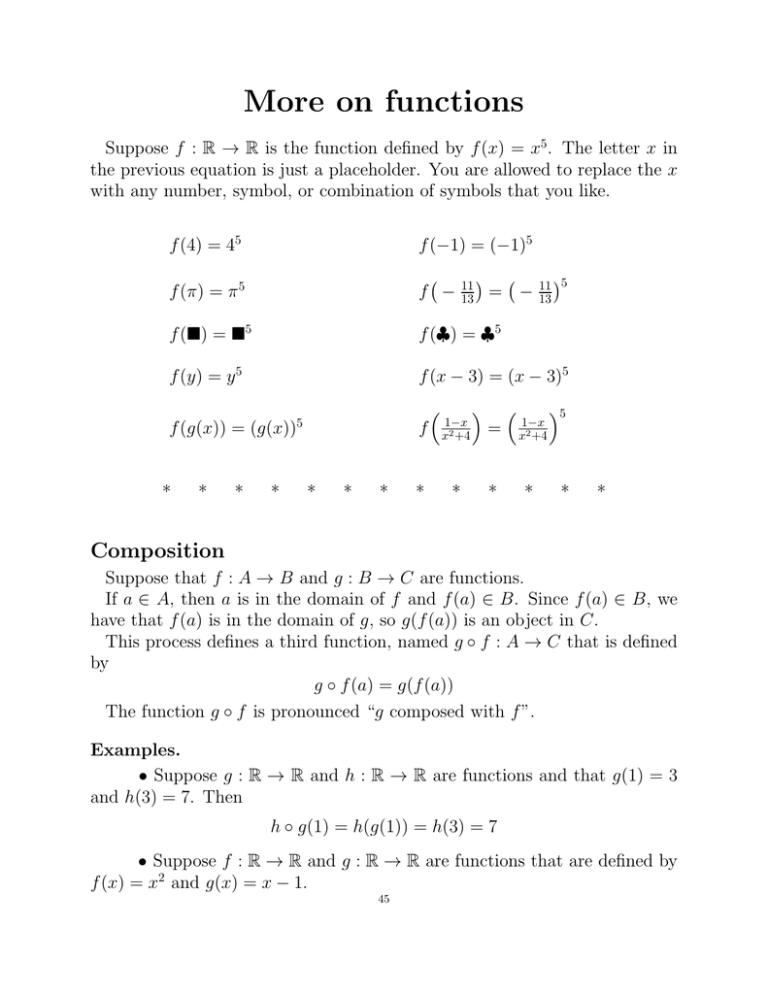
More on functions
Suppose f : R → R is the function defined by f (x) = x5 . The letter x in
the previous equation is just a placeholder. You are allowed to replace the x
with any number, symbol, or combination of symbols that you like.
f (4) = 45
f (−1) = (−1)5
�
f −
f (π) = π 5
f (�) = �5
*
�
= −
�
11 5
13
f (x − 3) = (x − 3)5
f (g(x)) = (g(x))
*
�
f (♣) = ♣5
f (y) = y 5
*
11
13
*
5
f
*
*
*
*
�
1−x
x2 +4
*
�
=
*
�
1−x
x2 +4
*
�5
*
*
Composition
Suppose that f : A → B and g : B → C are functions.
If a ∈ A, then a is in the domain of f and f (a) ∈ B. Since f (a) ∈ B, we
have that f (a) is in the domain of g, so g(f (a)) is an object in C.
This process defines a third function, named g ◦ f : A → C that is defined
by
g ◦ f (a) = g(f (a))
The function g ◦ f is pronounced “g composed with f ”.
Examples.
• Suppose g : R → R and h : R → R are functions and that g(1) = 3
and h(3) = 7. Then
h ◦ g(1) = h(g(1)) = h(3) = 7
• Suppose f : R → R and g : R → R are functions that are defined by
f (x) = x2 and g(x) = x − 1.
45
Then g ◦ f : R → R is the function defined by
g ◦ f (x) = g(f (x)) = g(x2 ) = x2 − 1
And f ◦ g : R → R is the function defined by
f ◦ g(x) = f (g(x)) = f (x − 1) = (x − 1)2
Important: Notice in the previous example that g◦f (2) = 3 and f ◦g(2) = 1.
That means that g ◦ f is not the same function as f ◦ g. In other words,
g ◦ f �= f ◦ g.
*
*
*
*
*
*
*
*
*
*
*
*
*
Range
Recall that the target of a function f : A → B is the set B. That means
that for any a ∈ A, we have that f (a) ∈ B.
But it might not be that every object in B has an object from A assigned
to it by the function f . For example, you might recall that if you square a
real number, the result is never a negative number (22 = 4, (−3)2 = 9, etc.).
Therefore, the function g : R → R defined by g(x) = x2 has R as its target,
although none of the negative numbers in the target have a number from the
domain assigned to it.
The range of a function f is the set of numbers that “come out of” f . For
example, if f : R → R is defined by f (x) = x − 2, then f (3) = 3 − 2 = 1. We
put 3 in to f , and got 1 out, so 1 is an object in the range.
Another way to say what the range is, is to say that it is the smallest set
that can serve as the target of the function.
Examples.
• Let h : {1, 2, 3, 4} → {3, 4, 7, 8, 9} be the function given by
h(1) = 9
h(2) = 4
h(3) = 4
h(4) = 8
If we put the numbers from the domain “in to” h, the only numbers that
“come out” are 9, 4, and 8. That means that the range of h is {9, 4, 8}.
46
• If g : R → R with g(x) =
g(1) =
x−1
x2 +1 ,
then
1−1
0
=
=0
12 + 1 2
and
2−1
1
=
22 + 1 5
Therefore, 0 and 15 are both objects in the range of g.
There
are also other numbers in the range of g. For example, g(4), g(−1),
√
g( 2), etc.
• The range of f : N → R where f (n) = (−1)n is the set {−1, 1}.
g(2) =
*
*
*
*
*
*
*
*
*
*
*
*
*
Implied domains
Sometimes we won’t go through the trouble of writing the entire name of a
function as “f : D → T where f (x) = x5 ”. This is similar to how we usually
call people by their first names, omitting their middle and last names, just
because it’s easier.
If we are introduced to a function that is given by an equation, and its
domain is not specified, we will assume that the domain for that function is
the largest subset of the real numbers possible. This set will be called the
implied domain of the function.
Examples.
• Let h(x) = 4x − 1. Then for any real number r ∈ R, h(r) = 4r − 1
makes sense, because it is a real number itself. Therefore, it is safe to put
any real number into h. Its implied domain is R.
5
• Let f (x) = x−1
. If r is a real number, then r − 1 is a real number.
5
As long as r − 1 �= 0, r−1
is also a real number. However, if r − 1 = 0, then
5
5
r−1 = 0 does not make sense – it is not a real number.
To recap, f (r) is a real number except when r − 1 = 0, or equivalently,
except when r = 1. Therefore, the numbers that it makes sense to “put in
to” f are all of the real numbers except for 1. Another way of saying the
previous sentence, is that the implied domain of f is the set R − {1}.
*
*
*
*
*
*
*
*
*
*
*
*
*
47
Exercises
For #1-6, assume that f (x) = x2 , g(x) = 2x − 1, and that h(x) = x − 5,
and match the given function with one of the following:
A. 2x − 11
B. x2 − 10x + 25
C. 2x − 6
D. x2 − 5
E. 2x2 − 1
F. 4x2 − 4x + 1
1) f ◦ g(x)
2) g ◦ f (x)
3) g ◦ h(x)
4) h ◦ g(x)
5) f ◦ h(x)
6) h ◦ f (x)
For #7-12, assume that f (x) = x+3, g(x) = 3x−4, and that h(x) = x2 +1,
and match the given function with one of the following:
A. 3x + 5
B. 9x2 − 24x + 17
C. 3x2 − 1
D. x2 + 6x + 10
E. x2 + 4
F. 3x − 1
7) f ◦ g(x)
8) g ◦ f (x)
9) g ◦ h(x)
10) h ◦ g(x)
11) f ◦ h(x)
12) h ◦ f (x)
48
13) What is the implied domain of f (x) = 3x − 4 ?
14) What is the implied domain of g(x) = x3 − 4x2 − 2x + 1 ?
15) What is the implied domain of h(x) = 15x − 3 ?
16) What is the implied domain of
f (x) =
1
?
x−3
17) What is the implied domain of
g(x) =
2x − 4
?
x+3
18) What is the implied domain of
3x2 − 4x + 5
h(x) =
?
−3x + 4
49
